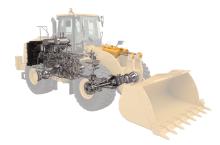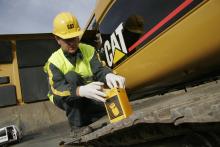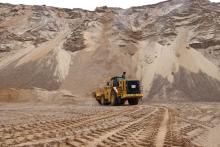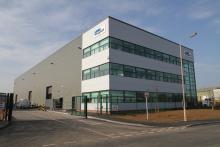
The design of modern machines is such that those carrying out regular maintenance and servicing today find the job much easier.
Manufacturers have made sure maintenance and service points on new machines are easily accessible, and that logistics are in place to be able to deliver the necessary wear and spare parts.
Even with regular maintenance, including such basics as oil and filter changes, there comes a time when any machine will require replacement of wear parts or indeed will need more major work.
This is usually factored in by the maintenance teams, and monitoring systems on the equipment from major manufacturers can give advance warning of any problems.
However, when spares and parts are required companies have to be ready with an almost instant response as downtime means lost productivity.
One sign of such requirements comes from
Its new expansion includes the construction of a new purpose-built head office that will incorporate its research and development, inspection, sales, administration and crusher training facilities alongside the substantial expansion of its existing crusher parts storage and distribution warehousing.
The new development of the facilities in Coalville is planned to start shortly and to be completed in Q1 of 2015. This latest development follows the recent substantial investment in the CMS Cepcor technical centre in Coalville which was commissioned in 2013. This subsequently included the integration of Baguley Precision Engineers, the wholly-owned UK manufacturing subsidiary business of CMS Cepcor into its Precision Services Division.
The new technical centre represented a substantial investment in new premises, and CNC manufacturing capability, which has further enhanced the manufacturing, inspection and repair facilities in Coalville and provided greatly improved manufacturing efficiency for the company.
These approved facilities include CNC, milling, turning, boring, slotting, grinding, drilling, pressing, welding, coordinate measuring, material testing and assembly.
Alongside the UK manufacture of crusher, screen, feeder and coating plant spare parts, the company is also experienced machining contractors to the rail, power, water treatment, brewery and oil exploration (including deep sea, rig head and pipeline) industries.
“In recent years CMS Cepcor has increasingly consolidated manufacture of its precision machined crusher spare parts in-house and the expansion facilities in Coalville will help to ensure we remain the genuine alternative to the original equipment manufacturer,” says Lee Hodges, commercial director.
Only recently
“There is a market need for parts that improve safety during maintenance and significantly reduce downtime,” says Jesper Persson, vice president crusher spare and wear parts, Sandvik Construction.
The three parts include the mainshaft sleeve, spider bushing and step components.
“Keeping cone crushers running with as short and as few maintenance stops as possible is critical for Sandvik’s customers, with the mainshaft sleeve, the spider bushing and the step components being important parts affecting cone crusher performance. Now, Sandvik has taken these parts to the next level.”
The new mainshaft sleeve, for example, can be changed in less than 15 minutes, an 80% quicker change when compared to current mainshaft sleeves on the market, says Sandvik Construction, which points out that for a cone crusher running at a capacity of 250tonnes/hour this rapid change would mean being able to produce 310tonnes during the 75 minutes production time gained. “With the new design from Sandvik there is no heating or grinding required: the new simplified procedure only requires a torque wrench and a hand driven oil pump, which also makes the changing process safer.”
Logistically,
For Volvo Penta, the Russian market has grown or held steady over the past decade, even in the years since the global recession, and while engines are selling well there, the company says the big story is the aftermarket.
In the Industrial segment, there are few Russian-based OEMs for Volvo Penta to sell to, but with hundreds of Volvo Penta-powered gensets and machines operating across the country, the aftermarket and customer service account for more than half of the Russian business.
Most of the population of Russia resides in the western part of the country, but Volvo Penta powers machines that work in oil and gas, mining and quarrying in the most remote locations of Siberia and the Far East.
Yet, Volvo Penta is ably handling end users’ needs, from St Petersburg to Vladivostok, says Vsevolod Gavrilov, head of Volvo Penta Russia.
With head offices in Moscow and St Petersburg, the company has a network of 30 dealers across the country as well as a budding partnership with
Over the next few years, Volvo Penta Russia’s focus will not be on recruiting any new dealers but rather on integrating more fully with Ferronordic and strengthening its existing network with comprehensive training.
“In such an enormous country, it’s impossible to have a presence in every village and town where our machines are operating,” says Gavrilov.
“But we can still find ways to make sure our customers don’t feel alone. Training is going to be the key to growth in Russia.
“By concentrating on total solutions, we can help customers achieve lower operating costs and better uptime. Creating a closer partnership can help them increase their overall efficiency. But first we need to make sure our dealers have the competence necessary to sell to big customers and manage complex business deals.”
Romulus Grosu, director of aftermarket sales and customer support for Region Emerging Markets and Asia Pacific (EM&APAC), says: “Russia is the first market in our region to really grasp the total solution concept. Russia is quickly becoming our benchmark for aftermarket solutions, as most of our global OEMs, such as Sandvik, Konecranes and Cargotec, have machines working there.”
Another piece of the aftermarket puzzle is spare parts. For key customers, Volvo Penta has installed an ordering system that ensures parts are delivered quickly and efficiently. Customers can check which parts are available online before placing their orders, and parts are shipped directly to the customer, rather than going first to the dealer.
For high mileage machines, which would normally be replaced after clocking up a certain number of kilometres, rebuilding or remanufacturing of equipment is becoming more popular, giving machines multiple lives. This service is offered by the major manufacturers.
“A new machine isn’t always the right fit. There’s budget or timing issues. A machine is paid off and you’d like to keep it that way. Or maybe your machine is a comfortable extension of everything you do. It’s yours, it’s dependable and you’d like to continue to get even more out of it,” says Volvo Construction Equipment.
“The Volvo Certified Refurbishment Program enables Volvo customers the ability to give a new life to higher hour Volvo equipment.”
One example is for the Cat 988 large wheeled loader, which was introduced in 1963, since when Caterpillar has manufactured more than 20,000 units.
Built to operate over multiple lives, the Cat 988 is one of the most rebuilt models within the Cat product line. Thousands of 988 units are at work with more than 20,000 hours of service while others have already accumulated more than 40,000 hours.
To assist with maximising machine life, Caterpillar designs and builds its machines and parts to be rebuilt and remanufactured. This results in a number of sustainable options for customers such as Cat Certified Rebuild and Cat
“In a Cat Certified Rebuild, the rebuild requirements are determined prior to disassembly through a comprehensive evaluation of the machine. The rebuild is then carried out according to strict Caterpillar developed guidelines. Certified machine rebuilds include automatic replacement of parts such as hoses, belts, seals, gaskets, bearings, knobs, wiring, switches and gauges. Included during reassembly are critical technological and engineering improvements that have been made since original manufacturing,” says Caterpillar.
“Retrofit packages are available to bring new features to older machines, maximising customers’ resources.With Cat Certified Rebuild, customers get a machine with like-new performance for a fraction of the cost of buying a new machine.”
Cat Reman offers remanufactured parts as one of the product support options available to support normal overhauls and repairs as well as Cat Certified Rebuilds. Cat Reman parts are remanufactured in a factory environment to Caterpillar specifications, ensuring same-as-new quality which is backed by a same-as-new warranty.
“The process also incorporates the latest engineering design changes ensuring the components meet the latest performance specifications. Cat Reman parts are available off-the-shelf and are priced at a fraction of the price of new parts, helping to minimise the customer’s operating costs. For wheeled loaders like the 988, Cat Reman offers engine, hydraulic and drive train components.
“Cat Reman and Cat Certified Rebuild are just two examples of the extensive product support options available to minimise customer operating costs. These make both economic and environmental sense because the programmes reduce waste and consumption of raw materials while providing lower cost to the customer. These programmes can deliver cost savings of 40 to 70%.
“The new Cat 988K wheeled loader is approximately 99% recyclable. This means that approximately 99% of the components and materials contained within the machine can be practically reused, remanufactured or reprocessed into primary materials and therefore reduce the need for virgin materials.”










